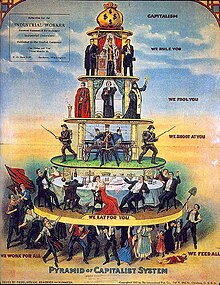Social stratification
Sociologists have put people into different categories, based on socioeconomic factors, such as wealth, income, race, education, ethnicity, gender, occupation, social status, or derived power (social and political). They called this classification social stratification. Stratification is the relative social position of people within a social group, category, geographic region, or social unit.[1][2][3]
In modern Western societies, social stratification is defined in terms of three social classes: an upper class, a middle class, and a lower class. Each class is divided in three again: an upper, a middle, and a lower layer, or statum.[4] Moreover, a social stratum can be formed upon the bases of kinship, clan, tribe, or caste, or all four.
Socieieties that are based on states, that have more than one center, or that have a feudal hierachy use social stratification. In feudal society, there is nobility, and there are the common people, or peasants. Social scientists still argue about when social stratification first appeared: Either it started in the hunter-gatherer, tribal, and band societies or with agriculture and large-scale means of social exchange.[5] Determining the structures of social stratification comes from inequalities of status among people.The degree of social inequality determines a person's social stratum. Generally, the greater the social complexity of a society, the more social stratification exists, by way of social differentiation.[6]
Stratification can yield various consequences. For instance, the stratification of neighborhoods based on spatial and racial factors can influence disparate access to mortgage credit.[7]
Social mobility
[change | change source]
People and groups or categories of people also move between the layers of the system. This movement can occur within one generation, or from one generation to the next one.
Mobility is sometimes used to classify different systems of social stratification. Systems that allow such mobility, or that make it easier are called open. Uually, they make movement possible by placing value on the achieved status characteristics of people. The societies with the highest levels of intragenerational mobility are considered to be the most open and malleable systems of stratification.[6] Those systems in which there is little to no mobility, even on an intergenerational basis, are considered closed stratification systems. For example, in caste systems, all aspects of social status are ascribed, such that one's social position at birth persists throughout one's lifetime.[9]

References
[change | change source]- ↑ "What Is Social Stratification?". Archived from the original on 4 March 2021. Retrieved 11 March 2021.
- ↑ "6.S: Social Stratification (Summary)". 13 December 2016. Archived from the original on 12 December 2019. Retrieved 11 March 2021.
- ↑ "What Is Social Stratification, and Why Does It Matter?". Archived from the original on 16 April 2021. Retrieved 11 March 2021.
- ↑ Saunders, Peter (1990). Social Class and Stratification. Routledge. ISBN 978-0-415-04125-6.
- ↑ Toye, David L. (May 2004). "The Emergence of Complex Societies: A Comparative Approach". World History Connected. 11 (2). Archived from the original on 2014-06-27. Retrieved 2014-06-27.
- ↑ 6.0 6.1 "Theories of Stratification and Inequality". The Concise Encyclopedia of Sociology. Wiley-Blackwell. 2011. pp. 622–624. doi:10.1002/9781405165518. ISBN 978-1405124331. Archived from the original on 1 September 2016. Retrieved 23 June 2014.
- ↑ Loya, Jose (2023). "Differential Access in Mortgage Credit: The Role of Neighborhood Spatial and Racial Stratification". Rural Sociology. 88 (2): 546–577. doi:10.1111/ruso.12485. Archived from the original on 2023-04-16. Retrieved 2023-04-16.
- ↑ 8.0 8.1 Data from Chetty, Raj; Jackson, Matthew O.; Kuchler, Theresa; Stroebel, Johannes; et al. (August 1, 2022). "Social capital I: measurement and associations with economic mobility". Nature. 608 (7921): 108–121. Bibcode:2022Natur.608..108C. doi:10.1038/s41586-022-04996-4. PMC 9352590. PMID 35915342. Charted in Leonhardt, David (August 1, 2022). "'Friending Bias' / A large new study offers clues about how lower-income children can rise up the economic ladder". The New York Times. Archived from the original on August 1, 2022.
- ↑ "Social Stratification". The Encyclopedia of Sociology. Macmillan Publishing Company. 1992. pp. 1955–70.
